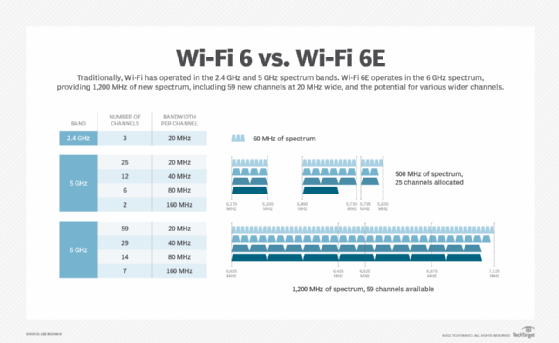
Wi-Fi 6 vs. Wi-Fi 6E vs. Wi-Fi 7: What are the differences?
Wi-Fi standards continue to evolve. The three most recent standards -- Wi-Fi 6, Wi-Fi 6E and Wi-Fi 7 -- build on each other's capabilities, but all have their own unique features.
Wi-Fi has always been a numbers game. Every Wi-Fi standard derives from the IEEE 802.11 working group, each with a different suffix that corresponds to its respective shorthand name. Today's most common Wi-Fi standards include Wi-Fi 6, Wi-Fi 6E and Wi-Fi 7.
Wireless networking vendors tout the huge throughput numbers each standard can enable. However, those who work in wireless networking, specifically Wi-Fi, know the reality tells a different story. Each standard differs from the last, even if they share the same working group. It's sometimes difficult to keep them all straight, but it's a good start to define the basics.
Wi-Fi 6 and 6E
Both Wi-Fi 6 and Wi-Fi 6E share the same Wi-Fi standard: 802.11ax. In the early part of the standard's tenure, it only operated on the 2.4 GHz and 5 GHz bands. This early version of the standard is Wi-Fi 6. Later, the 802.11ax standard brought the 6 GHz spectrum to Wi-Fi after the FCC approved the 5.925 GHz to 7.125 GHz frequency range for Wi-Fi use in the U.S. To differentiate 802.11ax before 6 GHz from 802.11ax with 6 GHz, Wi-Fi Alliance -- a nonprofit organization that develops Wi-Fi -- named the updated standard Wi-Fi 6E.
Because both Wi-Fi types share the same standard, they have the same critical feature set. Capabilities of Wi-Fi 6 and 6E include the following:
- 160 MHz wide channels. The most used widths in all bands are 20 MHz and 40 MHz. However, the 6 GHz spectrum uses 80 MHz where precision designs are in play. Only rare environments support 160 MHz wide channels -- and only in 6 GHz.
- Orthogonal frequency division multiple access (OFDMA). OFDMA offers multiclient efficiency gain compared to long-running single-device orthogonal frequency-division multiplexing.
- 1024 quadrature amplitude modulation (QAM). Wi-Fi 7 replaces 256 QAM with 1024 QAM. The higher modulation scheme enables faster top-end data rates if a given scenario has the proper characteristics to use the higher-speed feature sets.
- Basic service set (BSS) coloring. BSS coloring helps Wi-Fi clients operate more efficiently in the presence of a nearby wireless LAN (WLAN) with the same frequencies.

Wi-Fi 7
The latest IEEE wireless networking standard, 802.11be -- also known as Wi-Fi 7 -- operates on the same spectrum bands as Wi-Fi 6E: 2.4 GHz, 5 GHz and 6 GHz. As with any previous wireless standard, Wi-Fi 7 includes new features that promise higher performance on a well-designed network free of interference.
New features Wi-Fi 7 offers include the following:
- Channel widths up to 320 MHz in the 6 GHz spectrum. The highest throughput estimates need 320 MHz wide channels. However, this maximum throughput is more theoretical, as limitations of 6 GHz will make it hard to sustain these speeds realistically.
- 4096 QAM. When achievable, 4096 QAM modulation packs four times the amount of data into each transmitted signal compared to Wi-Fi 6's maximum 256 QAM. Vendor messaging might make it seem like all Wi-Fi 7 connections use 4096 QAM, but this isn't true. Most Wi-Fi 7 connections use lesser modulation schemes because of situational conditions.
- Multi-link operation (MLO). MLO enables simultaneous communication between client devices and access points (APs) on multiple frequency bands for higher aggregate data rates. However, it's unclear how viable this will be over time, as a device's ability to support MLO depends on its hardware specifications.
A solid wireless design is imperative for all Wi-Fi standards to perform to their potential. Higher frequency signals have a decreased usable range at the same output power. This means 6 GHz networks need more APs than WLANs built on Wi-Fi 6 and earlier. Because smaller devices have fewer antennas, client capabilities are less in networks with primarily mobile devices, such as phones and tablets, than in networks with larger devices, like laptops.
Wi-Fi 6 promised max speeds of up to 10 Gbps, while Wi-Fi 7 touts theoretical speeds above 40 Gbps. However, real-world situations aren't likely to achieve these values. Most client devices won't see those speeds in the network environment, which only adds to the inevitable fog that is part of modern Wi-Fi.
Wi-Fi 6 vs. Wi-Fi 6E vs. Wi-Fi 7
Wi-Fi 6, Wi-Fi 6E and Wi-Fi 7 are the three most recent types of Wi-Fi technology. Although the three standards have some characteristics in common -- for example, all three use the WPA3 protocol for security -- they each offer different capabilities.
The key difference between Wi-Fi 6 and 6E is the performance boost Wi-Fi 6E offers over Wi-Fi 6. Among other performance benefits, Wi-Fi 6E's improvements enable it to provide faster speeds, lower latency and more capacity over Wi-Fi 6. Wi-Fi 7 builds upon this further with the 802.11be standard, which delivers improvements to support high-demand applications. The table below compares Wi-Fi 6, Wi-Fi 6E and Wi-Fi 7.
| Wi-Fi 6 | Wi-Fi 6E | Wi-Fi 7 | |
| IEEE standard |
802.11ax |
802.11ax |
802.11be |
| Spectrum (GHz) |
2.4, 5 |
2.4, 5, 6 |
2.4, 5, 6 |
| Maximum spatial streams |
8 |
8 |
16 |
| MLO |
No |
No |
Yes |
| Maximum data rate (theoretical) |
9.6 |
9.6 |
30+ |
| Required security |
WPA3 |
WPA3 |
WPA3 |
Lee Badman is a network architect specializing in wireless and cloud technologies for a large private university. He's also an author and frequent presenter at industry events.







